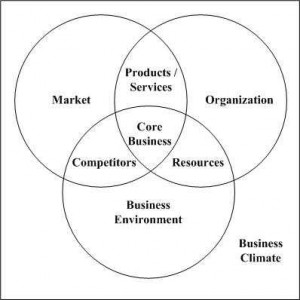Black Country Gifts (www.blackcountrygifts.co.uk) started trading four months ago. The information management in practice series discusses the challenges of managing information on a day-to-day basis in organizations. This blog reflects on the initial stages of setting up the business and the information that Black Country Gifts needs to manage.
Starting the Business
The business model (Figure 1) was used as a guide to help organize the information going into and coming out of Black Country Gifts. The business model focuses on the key question ‘What business are you in?’ and was discussed in the November 2014 post: http://www.managinginformation.org/what-business-are-you-in/
In the first phase of setting up the business, much of the information related to communication with external organizations in the business climate, such as the HM Revenue and Customs, and the UK Information Commission. The focus was on establishing the organization as a trading entity.
The focus of information exchange then turned to the business environment section of the business model. This included communication with banks and web hosting companies to continue setting up the business. Attention was then given to identifying suppliers for the items to stock.
Setting up the internal processes in the organization circle involved a trade-off between tailoring the information processes to meet the specific needs of the organization and the limitations of the software being used to manage the online retail web site. Processes were established to manage the information received from and sent to suppliers, manage the stock, record transactions and maintain the financial information.
Attention then moved to the market circle of the business model and the information exchanged with customers and potential customers. Processes had been set up to manage transactions but further work was needed about the specific information given to customers about the range of products available and the nature of the organization.
Developing the Business
The information systems architecture and IT architecture have been successfully established to support the operational transactions of Black Country Gifts. More attention is now being given to the interaction with customers and the information being conveyed to customers. Basic statistical data have been captured about visitors to the web site, which has helped to identify successful search strategies that have led visitors to the site. Further analysis of the data is needed to inform decisions about the information provided about products and the general information displayed on the web site.
The business has a Twitter account (@BCGwm) but the business has not yet established its identity with the Twitter account. Tweets are mixed, relating to products, occasions when gifts may need to be purchased, local news and information for businesses. The tweets therefore reflect the multiple roles of Black Country Gifts as an online retailer targeting customers, a local business grounded in the local community, and a local business sharing information with other businesses. Analysis of the re-tweets show that the two most re-tweeted tweets related to a blog posted on the company’s web site ‘How to Choose a Gift’ and a re-tweet from @manginforg.
The further development of the web site also needs to be considered in terms of the information content provided in addition to the information about its product range. The original mission of the organization was to sell locally produced gifts to showcase the heritage and skills of the area. T he medium-term strategy was to sell low-cost gift items to build capital for investment in a unique commissioned product range. The current challenges relate to how to establish the organization’s identity during this initial start-up phase, through the information communicated about the company on its web site and through social media.
Lessons Learnt
- The business model provides an initial structure to help focus on the key information exchanges that the organization needs to manage when starting up a business.
- Time spent defining information processes and establishing information management procedures at the start, made launching the organization and initial trading easier.
- The organization has to have processes in place to manage the different relationships between the parties identified in the business model.
- It is important not to overlook the content of the information communicated as well as management of the processes to create and maintain the information.
- The organization’s identity needs to be clearly defined in order to provide the context for the information communicated; multiple roles may suggest that multiple communication channels may be required.
Information management in practice requires specific consideration to be given to different groups of people and organizations. The business model provides a clear structure to help new businesses starting up to focus attention on the different information needs of the different organizations that the business needs to share information with.
Further Reading: The business model is discussed in Chapter 1 and Chapter 2.

